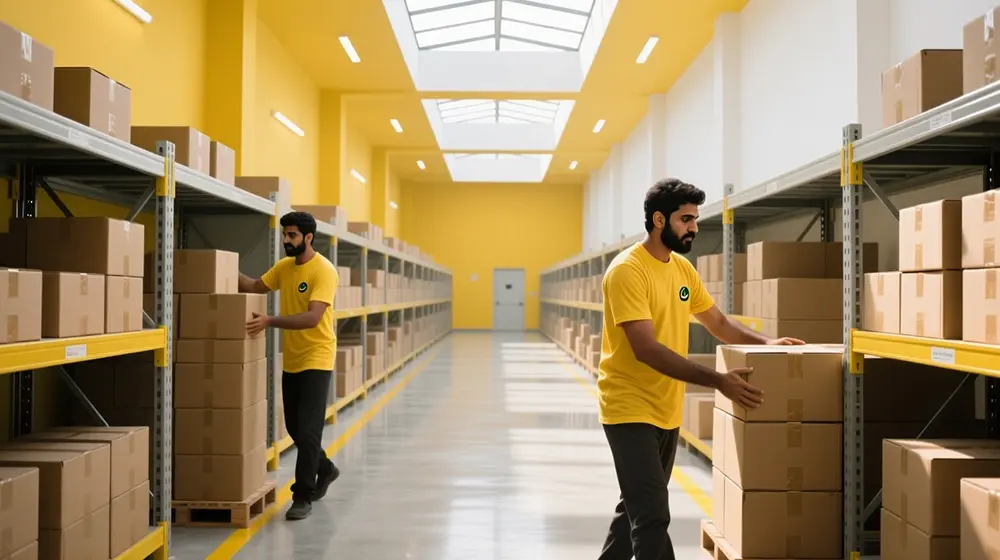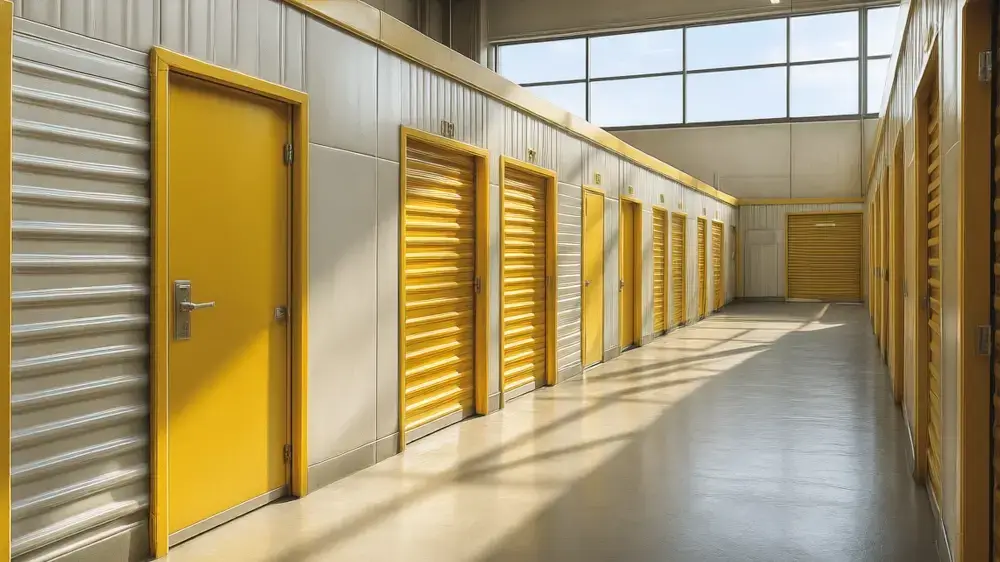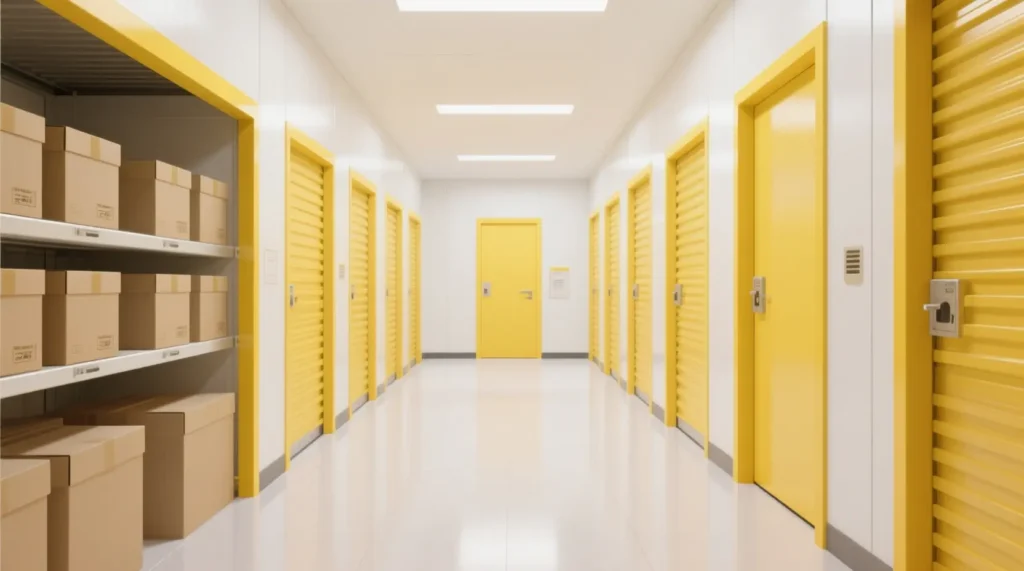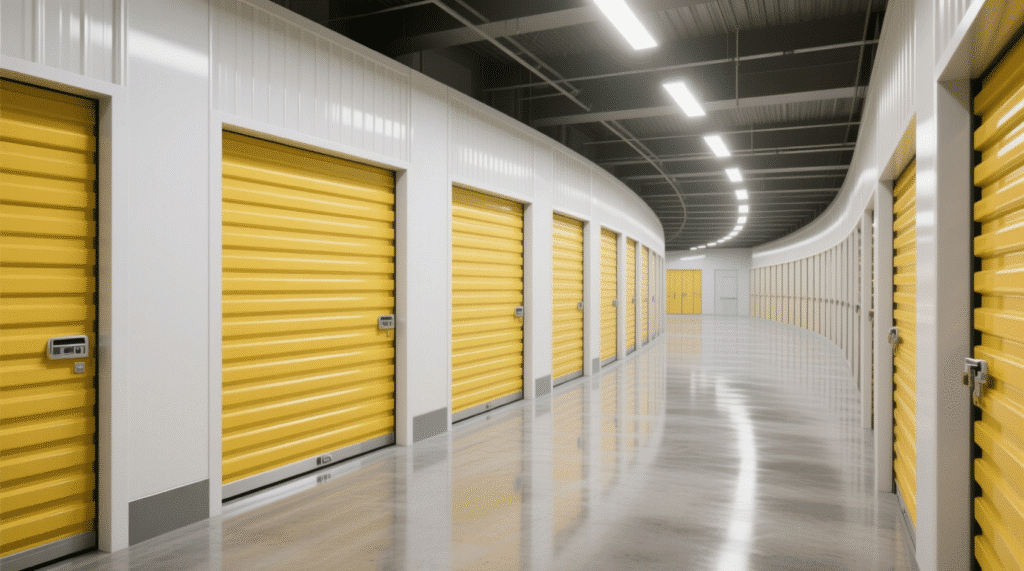Dubai’s hot, arid desert climate creates storage challenges that persist throughout the year. While summer is marked by extreme heat and humidity, other seasons present their own threats: spring brings sand and dust, autumn retains high moisture levels, and winter can cause condensation. Furniture may warp, clothing can fade, and electronics might rust or short-circuit. During the summer of 2025, inland temperatures climbed to 51.8 °C, with coastal humidity recorded at 81%.
This seasonal storage guide provides practical steps to safeguard possessions in every part of the year

Seasonal Climate Risks in UAE
To create an effective seasonal storage plan, start with the UAE’s climate profile. Every season brings distinct stress factors that require targeted responses.
Common Damage Types:
- Warping and cracking of wood furniture
- Mold growth in textiles, books, and paper
- Corrosion on electronics and metals
- Leather stiffening and fading
| Season | Climate Characteristics | Primary Risks for Storage |
|---|---|---|
| Spring (Mar–May) | Rising temperatures of 25–38 °C, frequent dust storms | Dust infiltration, abrasion, and early corrosion |
| Summer (Jun–Sep) | Extreme heat 40–52 °C, RH up to 80% | Mold, warping, and electronics corrosion |
| Autumn (Oct–Nov) | Cooling temps 25–35 °C, humidity lingers | Post-summer mold growth, textile mildew |
| Winter (Dec–Feb) | 15–25 °C, lower inland RH, coastal humidity | Condensation, material contraction |
Spring Storage Tips: Managing Dust and Transition Heat
Spring in the UAE is a transitional period with frequent dust storms and rising temperatures. Storage during this season must emphasize dust control and early preparation for summer heat.
Risks in spring:
- High frequency of dust storms, depositing salts and corrosive particles.
- Temperatures climb to 30–38 °C, raising stress on stored wood, leather, and paper.
Storage tips for spring:
- Use airtight, gasket-sealed containers to prevent dust entry.
- Cover large items with dustproof cotton cloths; avoid plastic that traps humidity.
- Install dust filters on storage vents.
- Inspect electronics and apply silica gel packs. Dust + moisture accelerates the corrosion of printed circuit boards (PCBs).
Summer Storage Tips: Heat and Humidity Protection
With temperatures approaching 50°C and humidity levels exceeding 90%, the summer in Dubai and other parts of the UAE is harsher than most people would expect. Seasonal storage here must emphasize climate control and mold prevention.
Tips:
- Choose climate-controlled storage units (18–24 °C, 30–50% RH).
- Pack belongings in acid-free boxes and breathable cotton covers.
- Place desiccants in sealed containers; replace monthly.
- Inspect every 8–12 weeks, especially after dust storms.
What risks do UAE summers pose for stored items?
The UAE summer is subject to extreme heat, high humidity, and dust storms. According to Dubai climate data, daytime highs exceed 38 °C regularly, while humidity may reach 90 % near the coast. These conditions cause:
- Wood warping, cracking, and veneer delamination
- Mold, mildew, and odor in textiles and paper
- Corrosion of metal and electronics
- Yellowing, ink bleeding, and glue separation in documents/photos
- Leather moisture loss, stiffening, and tear risk
Damage often begins within 24–48 hours of exposure above safe humidity levels.

Autumn Storage Tips: Post-Summer Humidity Monitoring
Autumn feels cooler, but humidity remains a storage hazard. The transition from hot, humid summers to milder autumns can cause moisture retention in textiles, electronics, and stored documents.
Risks in autumn:
- 25–35 °C average but still > 60% RH in many coastal areas.
- Condensation on stored electronics occurs when they are moved between AC interiors and humid outdoor air.
Storage tips for autumn:
- Inspect storage immediately after summer; check textiles, paper, and leather for mold stains.
- Maintain RH < 55% with dehumidifiers.
- Use cotton garment bags for clothes and buffer paper in folds.
- Rotate stored textiles and furniture to release trapped air.
Winter Storage Tips: Preventing Condensation and Fluctuations
Winter offers relief from UAE heat, but coastal humidity and temperature fluctuations still threaten belongings. Storage must prevent condensation cycles that occur between cool exteriors and heated indoor spaces.
Risks in winter:
- Daytime 20–25 °C; night lows near 15 °C.
- Condensation risk when cold objects are moved into warm AC rooms.
- Metals corrode faster in humid, cool air.
Storage tips for winter:
- Use ventilation gaps to avoid condensation pockets.
- Store metal items with anti-corrosion papers or VCI (volatile corrosion inhibitors).
- Avoid placing storage boxes directly against cold walls or floors.
- Inspect leather and textiles for stiffness from low RH.
Seasonal Storage Strategies: Year-Round Overview
Seasonal storage in the UAE requires different strategies throughout the year. Spring demands dust protection, summer requires full climate control, autumn emphasizes humidity management, and winter calls for condensation prevention.
| Season | Key Risks | Storage Strategy | Best Practices |
|---|---|---|---|
| Spring | Dust storms, rising heat | Airtight containers, dust filters | Clean electronics, prepare climate control |
| Summer | Heat 50+ °C, RH 80% | Climate-controlled storage | Acid-free boxes, silica gel, breathable covers |
| Autumn | Lingering humidity | Dehumidification focus | Dry textiles, acclimate belongings |
| Winter | Condensation cycles | Desiccants, ventilation | Rotate items, gradual acclimatization |
Proper storage ensures that when summer breaks and holiday travels are over, valuables remain in pristine condition, no matter the season.
Inspection Frequency Across Seasons
Inspections are vital year-round. Seasonal risks differ, but routine checks ensure belongings remain safe.
- Spring: Check after dust storms; clean surfaces and refresh desiccants.
- Summer: Inspect every 8–12 weeks; look for mold, warping, and rust.
- Autumn: Focus on textiles and books for mildew growth.
- Winter: Watch for condensation on metals and electronics.
Watch for
- Musty or mold odors
- Warping, delamination, blistering
- White oxidation or rust on metal
- Yellowing or ink bleed on paper
- Leather dryness, cracking, or stiffness
If signs appear, air the unit (if safe), deploy more desiccants, or relocate to a better climate unit.

How do you pack for climate-resilient seasonal storage in the UAE?
Packing is the frontline defense for belongings in UAE summer storage. Proper packing mitigates dust, humidity, and temperature shocks.
Checklist:
- Acid-free boxes for documents and photos
- Breathable cotton covers for wood and leather furniture
- Desiccant sachets in sealed containers to absorb residual moisture
- Elevate items on pallets or shelves, away from direct floor or wall contact
- Ventilation gaps to prevent stagnant humidity pockets
- Inventory labels for quick retrieval and inspection
The U.S. Environmental Protection Agency (EPA) guidance warns against sealed plastic wrapping in humid climates, since trapped moisture above 60% RH fosters mold.
Safe Retrieval Tips After Storage
Acclimating belongings prevents sudden shock from moving them between storage and indoor conditions.
Steps:
- Air items in a shaded, ventilated room for 24–48 hours.
- Let electronics rest 2–4 hours before powering.
- Launder/dry-clean clothing; apply conditioner to leather.
How do you protect specific categories?
Apply material-appropriate targets and archival methods to protect each category.
Books, documents, photographs
- A good storage environment is arguably the most important preservation measure for photographic materials.
- Store in cool (≤ 21 °C), relatively dry (30–50% RH) spaces; avoid attics/garages with extreme swings.
- Use acid-free boxes/folders and minimize daily RH fluctuation to ≤ 5–10%.
- Keep photographs away from light; for mixed collections, hold ~40–50% RH to avoid stressing non-photo materials
Leather goods (bags, shoes, jackets)
- Maintain ≤ 25 °C with ~45–65% RH and airflow; high humidity plus warmth triggers mold and red-rot.
- Avoid plastic wrap; use breathable cotton covers and neutral-pH tissue.
- If mold occurs, know growth timeframes (e.g., ~2 days; 90–100% RH) and dry/clean promptly
Electronics & appliances
- Seal devices in anti-static bags with desiccants; remove batteries and store cables loosely coiled.
- RH drives creep corrosion on PCBs; susceptibility differs by metal finish and contaminant load across 15–80% RH.
- Keep units off floors; use shelves to reduce dust deposition pathways.
Textiles & clothing
- Clean before storage; use cotton garment bags; maintain < 55% RH for mildew control.
- Add buffer paper between folds to limit creasing and dye transfer.
- Avoid perfume or food residues that attract pests.
Artwork & musical instruments
- For mixed collections, many institutions target ~45–50% RH with minimal fluctuation; ~20–22 °C improves stability.
- Use padded cradles, string slackeners (instruments), and UV-shielded covers for framed works.
- Keep artworks away from vents and direct sunlight.

What is the cost vs. damage-risk tradeoff for climate-controlled storage in UAE?
Climate-controlled units command a premium of ~20–30 % over regular units in UAE due to HVAC, HVAC backup, monitoring, insulation, and energy costs. Warehouse lease rates for temperature storage in UAE run AED 30–60 per sq ft per year (base lease before OPEX). Compare premium cost × months vs. probable replacement/repair cost. Example: if the premium is AED 200/month but the damage risk likely exceeds AED 2,000 for furniture + electronics, payback occurs within ~10 months.
Industry reports cite 3–5 year CAPEX payback for climate-controlled self storage operators in UAE markets.
What temperature and humidity levels keep stored items safe?
Humidity is the most damaging environmental factor in UAE seasonal storage. Unlike temperature, which fluctuates daily, humidity builds up and creates long-lasting risks for belongings. Maintaining the right storage environment is the foundation of every seasonal storage tip for UAE summers.
Recommended Ranges:
- Temperature: 18–24 °C
- Relative Humidity (RH): 30–55%
These ranges are used by museums and archival institutions worldwide to preserve organic materials. In UAE summers, only climate-controlled storage facilities can maintain such stability.
Why is humidity control critical in UAE summer storage?
Moisture is the primary driver of deterioration in storage. High RH elevates mold risk, speeds metal corrosion, and degrades adhesives, inks, and coatings.
UAE amplification: Coastal humidity and enclosed units can sustain > 60% RH unless actively dehumidified.
Facts you can act on:
- Mold threshold: Keep indoor RH below 60%, ideally 30–50%, to limit fungal growth and condensation risk.
- Time-to-mold: At 90–100% RH, mold may appear in ~2 days; at 80% RH, around 10 days; at 70% RH, around 100 days.
- Creep corrosion: RH drives conductive residue formation and corrosion on PCBs; risk increases across 15–80% RH, depending on finish/contaminants.
Add micro-controls inside boxes: Place silica gel or molecular sieves, log RH with compact sensors, and avoid sealed plastic wraps that trap moisture.
Importance of Humidity Control
Humidity control is even more critical than temperature in UAE summer storage. Moisture also speeds up corrosion of metals and creep corrosion on electronics, making humidity management critical.
- Mold risk: Mold begins above 60% RH.
- Fungal stains: High humidity accelerates mildew on books, fabrics, and photos.
- Corrosion: Electronics and metals fail faster under moist air.
Tip: Always use desiccants and RH sensors inside storage boxes to maintain a protective micro-climate.
Do dust storms matter for seasonal storage in the UAE?
Dust is an under-estimated seasonal storage risk in UAE summers. Alongside heat and humidity, dust storms add a corrosive and hygroscopic layer to belongings.
A study analyzing eight years (2010–2017) of UAE dust storm data concluded that these events occur regularly, depositing salts, metals, and fine particles indoors. When belongings are stored without sealing, dust increases water absorption, raises RH around items, and creates a substrate for mold.
Seasonal storage tips must include airtight bins, box sealing, and dust filters to prevent contamination during UAE summer breaks.
Select climate-controlled storage when items are heat-sensitive, stored over summer months, or located in coastal/humid zones.
How do you choose between climate-controlled and regular storage in UAE?
Use this decision checklist:
| Condition | Use Climate Control? | Reason |
|---|---|---|
| Storing from May to September | Yes | Peak heat and humidity occur then |
| Items: wood, leather, electronics, art, documents, musical instruments | Yes | These are vulnerable to warping, corrosion, mold, and delamination |
| Proximity to coast / high ambient humidity | Yes | Coastal RH surge worsens damage risk |
| Short-term storage of metal tools or rugged gear | Maybe not | These tolerate more fluctuation (though dust & corrosion are still risks) |
As an example, Ruby Self Storage recommends climate control for most items in Dubai because unmitigated heat and humidity “damage fragile materials” over time. Similarly, Delight Self Storage asserts that in summers exceeding 40 °C and RH over 70 %, uncontrolled units risk mold within 24–48 hours.
Thus, for most household items in the UAE summers, climate-controlled storage is the safer default.
Climate-Controlled vs Regular Storage
Choosing the right storage type is one of the most important seasonal storage decisions.
| Factor | Climate-Controlled Storage | Regular Storage |
|---|---|---|
| Temperature | 18–24 °C | Matches outside heat (40–50 °C) |
| Humidity | 30–55% RH | Often 70–90% RH |
| Cost | ~20–30% higher | Lower |
| Protection | Protects wood, leather, electronics, photos, and documents | Only suitable for rugged, non-sensitive items |
Recommendation: For 80% of belongings, climate-controlled storage is the safest option in UAE summers.

Should you choose climate-controlled storage for UAE summer breaks?
Choosing between regular and climate-controlled storage is the single most important seasonal storage decision in the UAE summers.
Sensitive belongings such as wood furniture, leather goods, textiles, artworks, electronics, and documents require climate control, especially when stored between May and September. Museum standards recommend stable conditions within 25–65% RH for mixed materials, with limited daily fluctuations.
Regular storage may suffice for rugged, sealed tools or inert goods, but for 80% of household items in UAE summers, climate-controlled storage is the only safe option.
Final Word: Seasonal Storage Tips in UAE for Year-Round Protection
Seasonal storage in the UAE requires different strategies per season:
- Spring: Dust protection
- Summer: Heat & humidity control
- Autumn: Post-summer humidity monitoring
- Winter: Condensation prevention
Spring demands dust-proofing, summer requires strict climate control, autumn emphasizes humidity monitoring, and winter calls for condensation prevention.
The most effective solution is to invest in climate-controlled storage, maintain a temperature between 18–24 °C, and keep relative humidity within 30–55%. Complement this with archival-quality packing materials, desiccants, and scheduled inspections every 8–12 weeks. By applying these seasonal storage tips in the UAE, residents can safeguard furniture, electronics, textiles, documents, and leather goods.
In short, anticipate seasonal risks, choose the right storage method, and protect valuables year-round.
Frequently Asked Questions (FAQs) on Seasonal Storage in UAE
Why is seasonal storage important in the UAE?
Seasonal storage is critical in the UAE because extreme summer heat, high humidity, dust storms, and winter condensation all threaten stored belongings. Without proper storage, items like wood, electronics, and textiles can deteriorate within weeks.
What are the biggest risks for storage in UAE summers?
UAE summers bring temperatures up to 52 °C and RH levels reaching 80%, which cause mold, warping of wood, corrosion in electronics, and mildew in textiles.
How do dust storms affect belongings in UAE storage?
Dust storms deposit salts, metals, and fine particles that accelerate corrosion, increase moisture absorption, and provide a substrate for mold growth. Airtight bins and dustproof covers are essential in spring and summer.
What is the best temperature and humidity for storing items in UAE?
The safest storage environment is 18–24 °C with 30–50% relative humidity (RH). Museums and archival institutions use these ranges to preserve organic materials.
Do I always need climate-controlled storage in UAE?
Yes, for most household belongings such as furniture, leather, textiles, electronics, and documents, especially between May and September. Rugged tools or sealed plastic goods may tolerate regular storage.
What seasonal storage tips are specific to autumn in UAE?
In autumn, focus on humidity monitoring. Even though temperatures drop to 25–35 °C, high RH lingers. Use dehumidifiers, cotton garment bags, and buffer papers to prevent mildew and curling of documents.
What should I watch for during winter storage in UAE?
Winter storage risks include condensation cycles and metal corrosion. Avoid placing boxes against cold walls, add ventilation gaps, and use desiccant packs to prevent moisture buildup.
How often should I inspect my belongings in storage?
Inspect storage every 8–12 weeks year-round. After dust storms, check seals, replace desiccants, and look for mold, warping, rust spots, or odors.
What packing materials are best for seasonal storage in UAE?
Use acid-free boxes for documents/photos, breathable cotton covers for furniture and leather, anti-static bags for electronics, and desiccant sachets to absorb residual moisture.
Is climate-controlled storage cost-effective in UAE?
Yes. While climate-controlled storage costs 20–30% more, the protection it provides can prevent damages that would cost thousands of dirhams to repair or replace.

